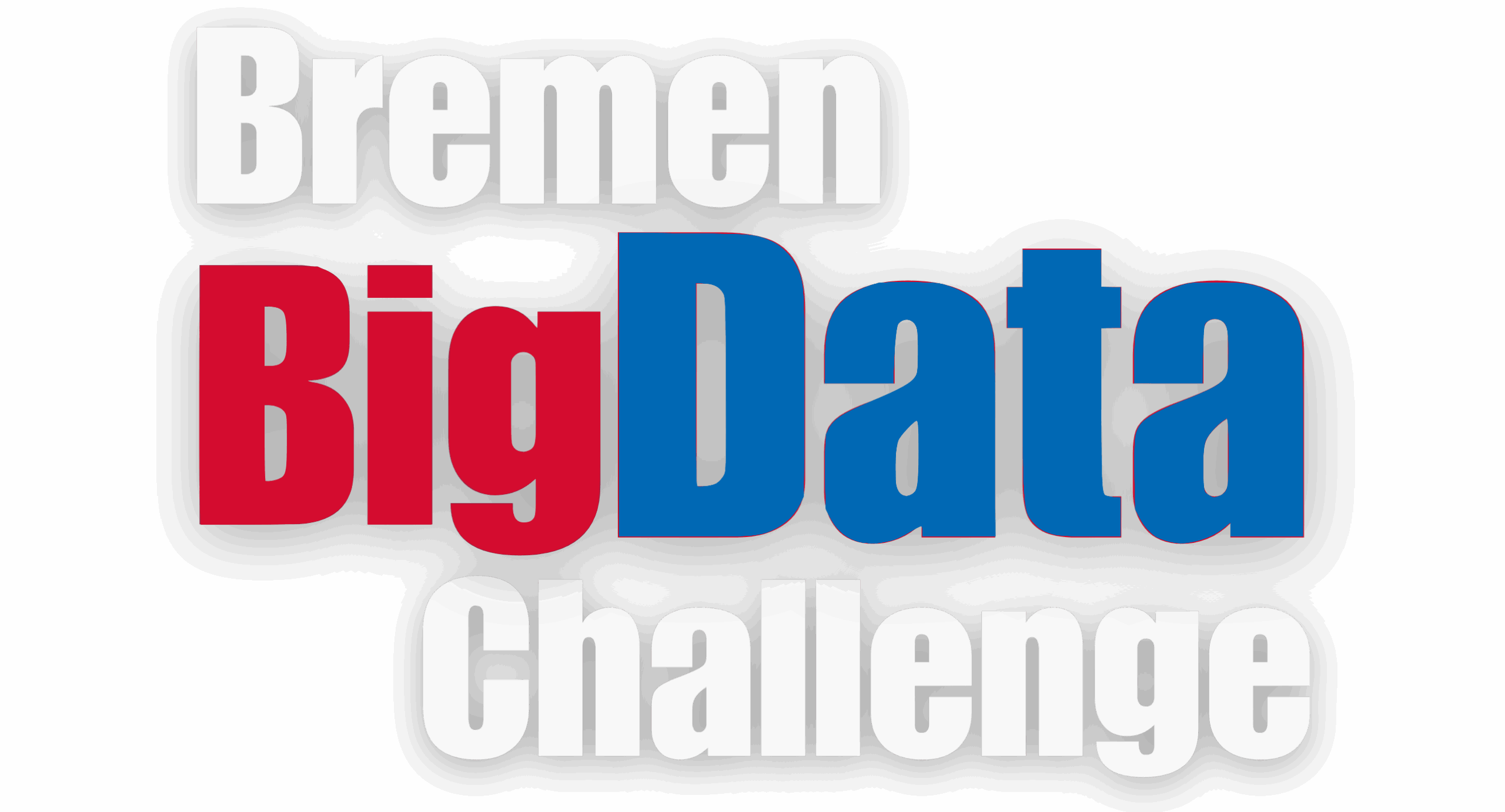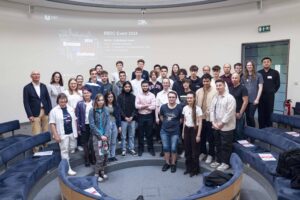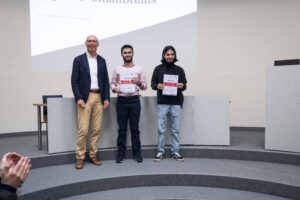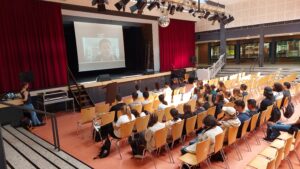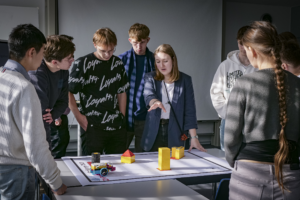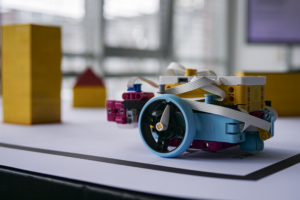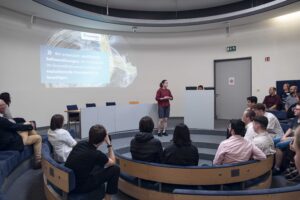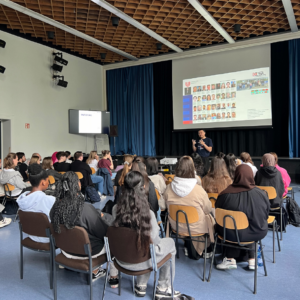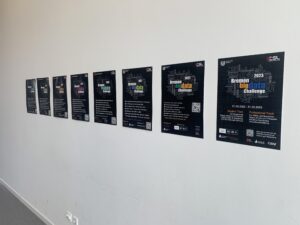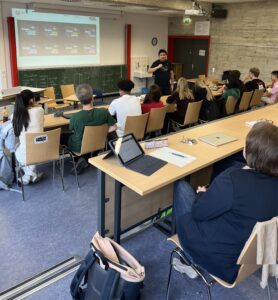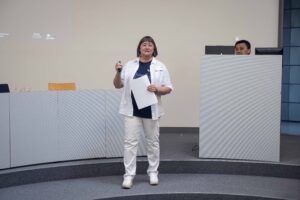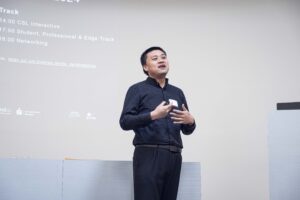Basic Track
Come by & experience big data!
Der Basic Track richtet sich an Gymnasiasten. In dem Datenanalyse-Wettbewerb des Cognitive Systems Lab (CSL), und des Zentrums für angewandte Raumfahrttechnologie und Mikrogravitation (ZARM) der Universität Bremen sowie dem Fraunhofer-Institut für digitale Medizin (MEVIS) messen sich Teilnehmende um Preisgelder bis 1.500 Euro, und attraktive Sachpreise.
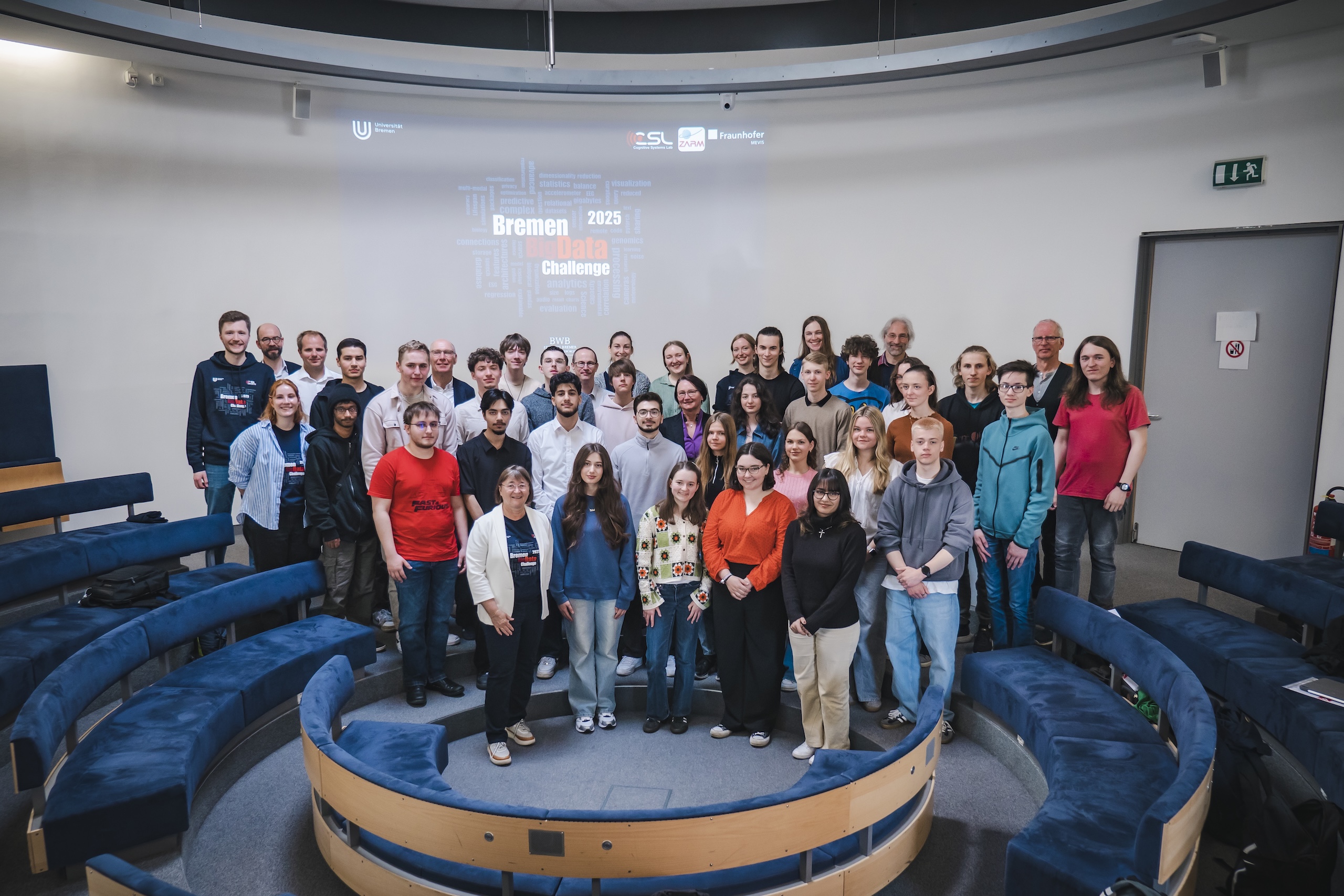
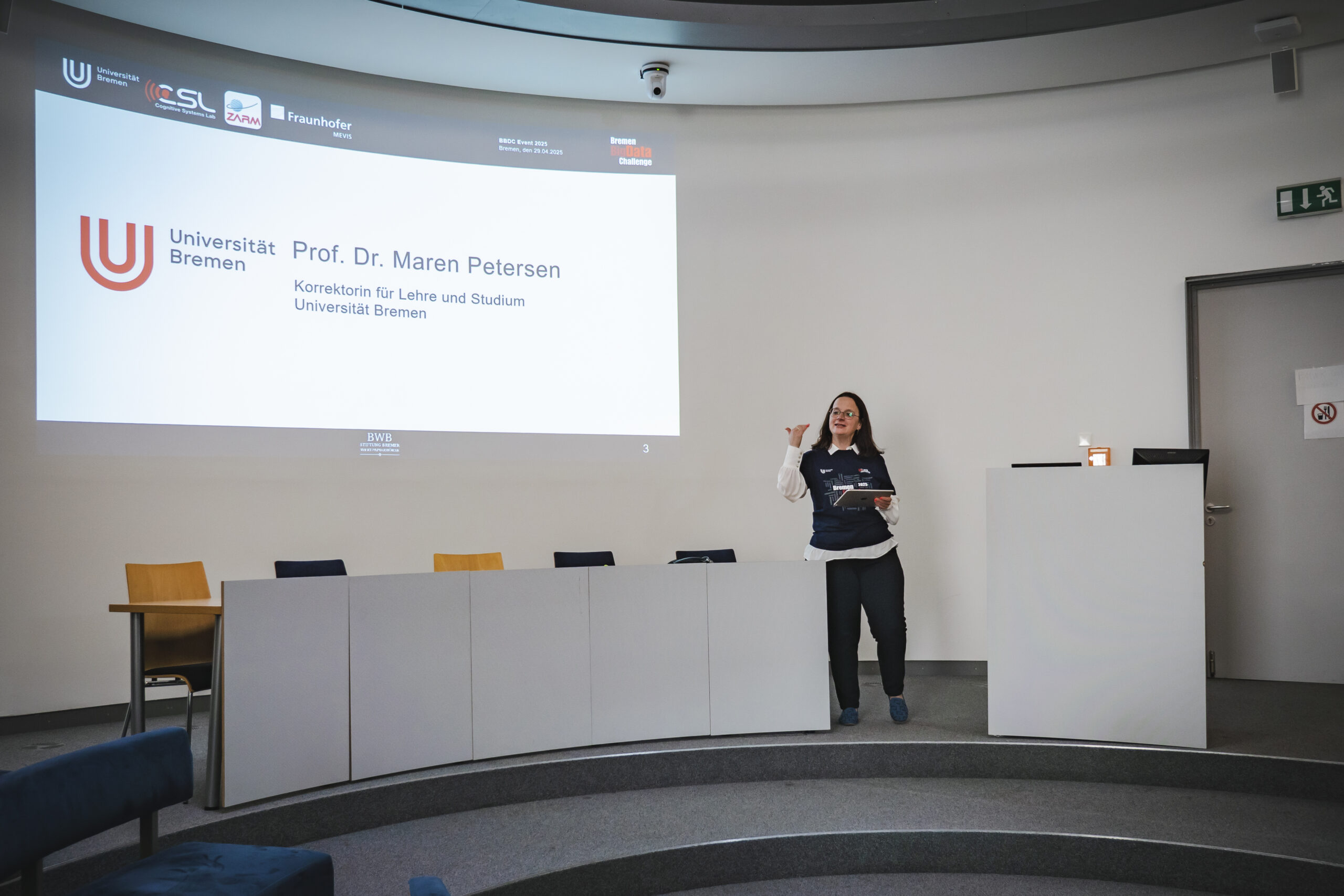
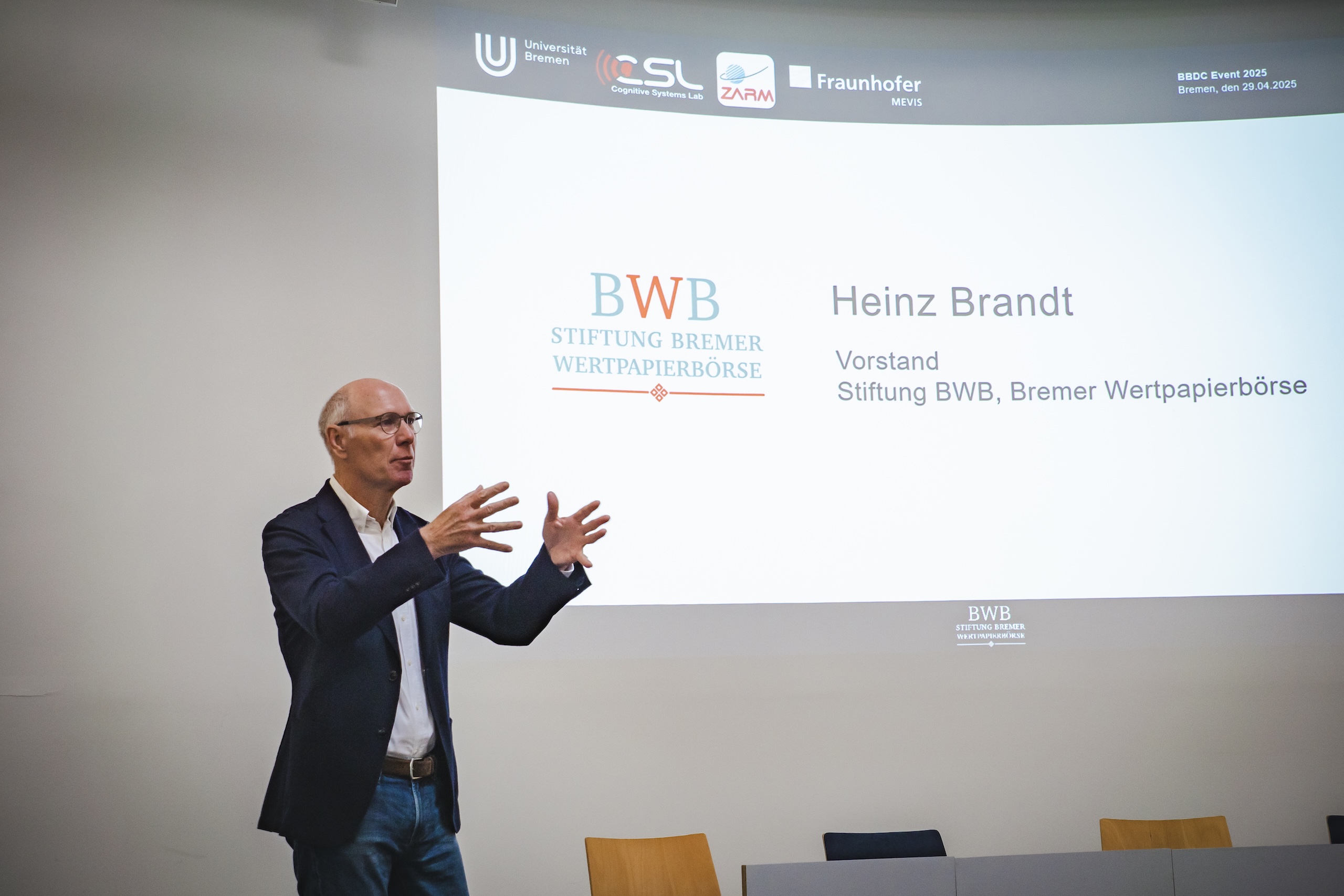
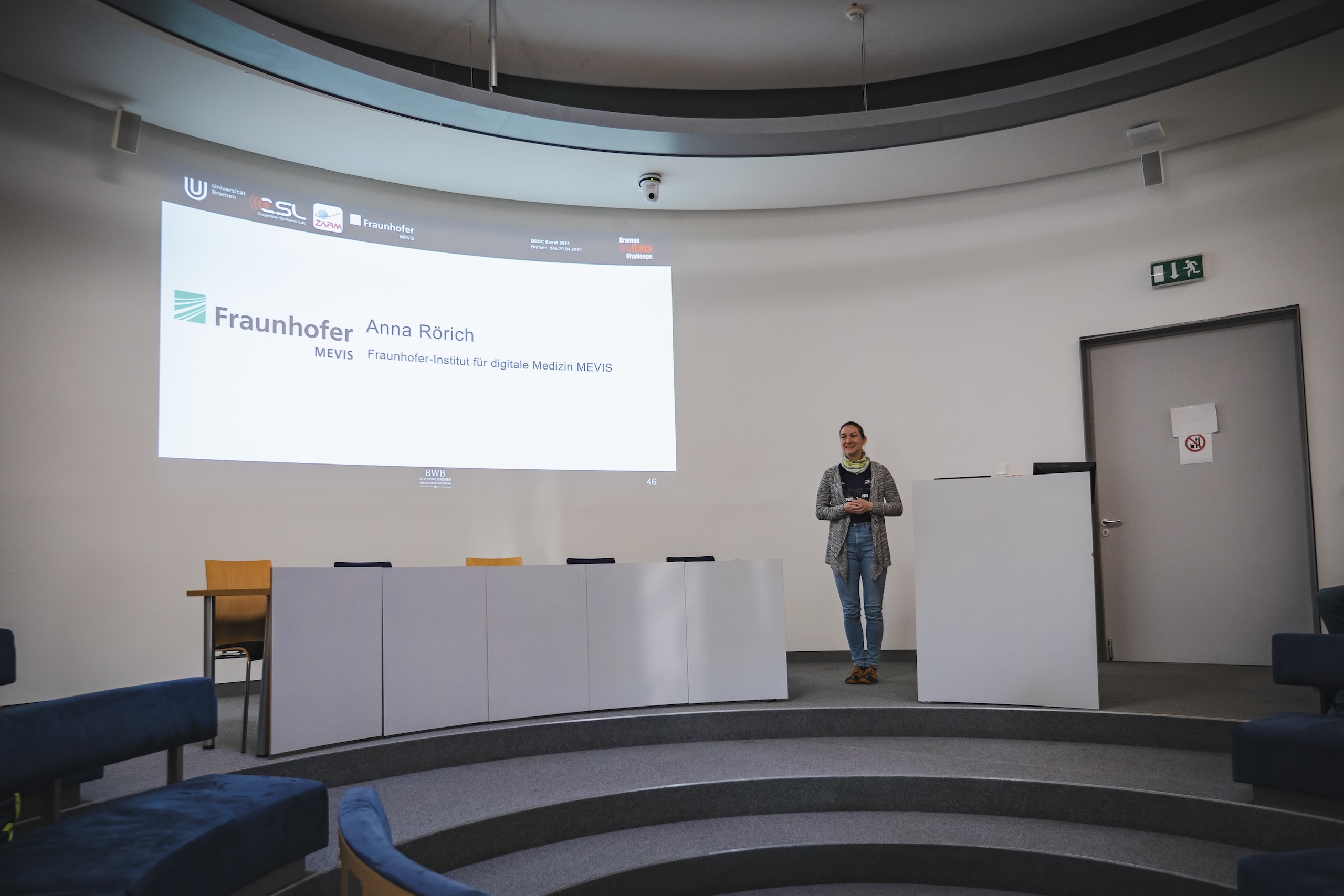
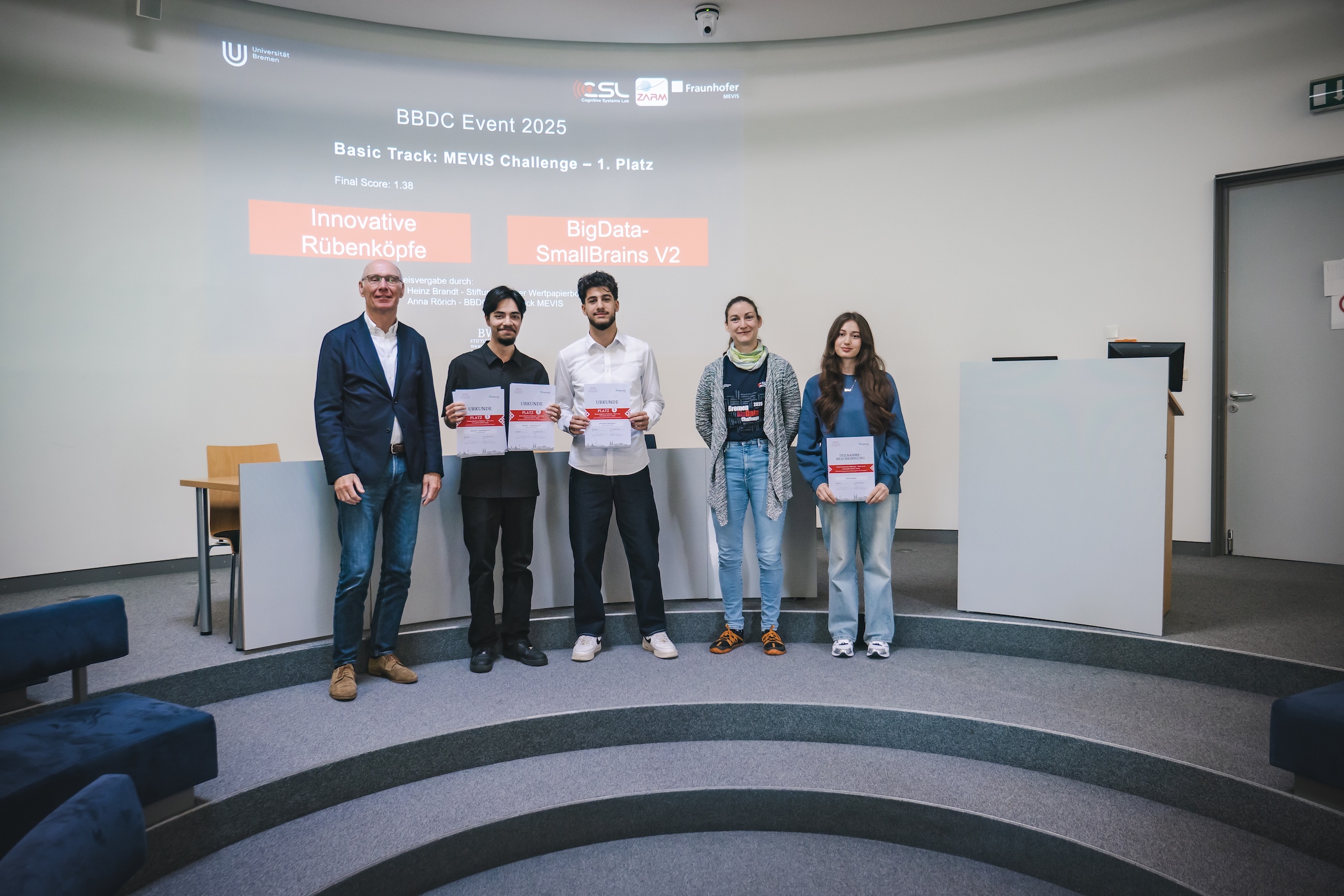
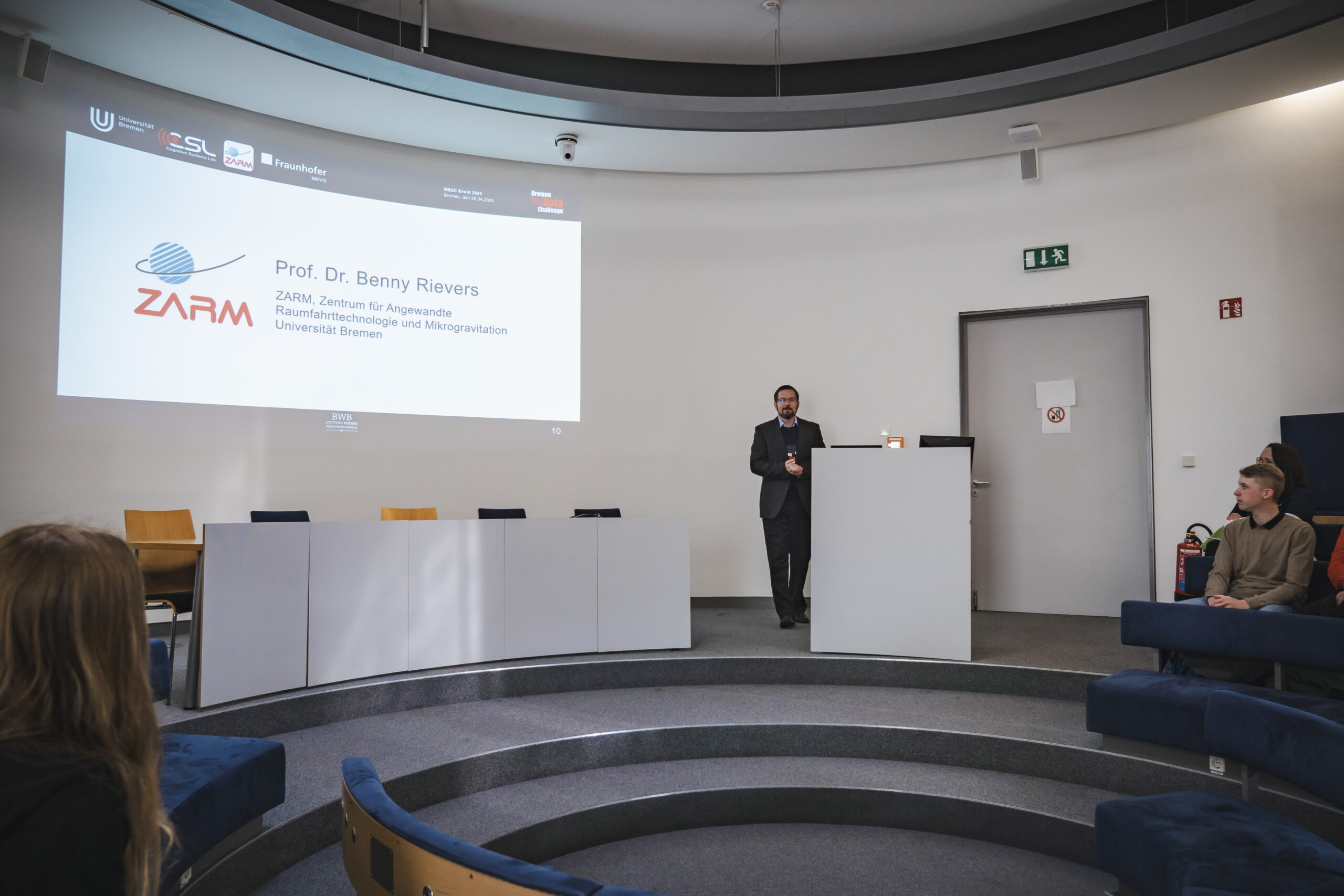
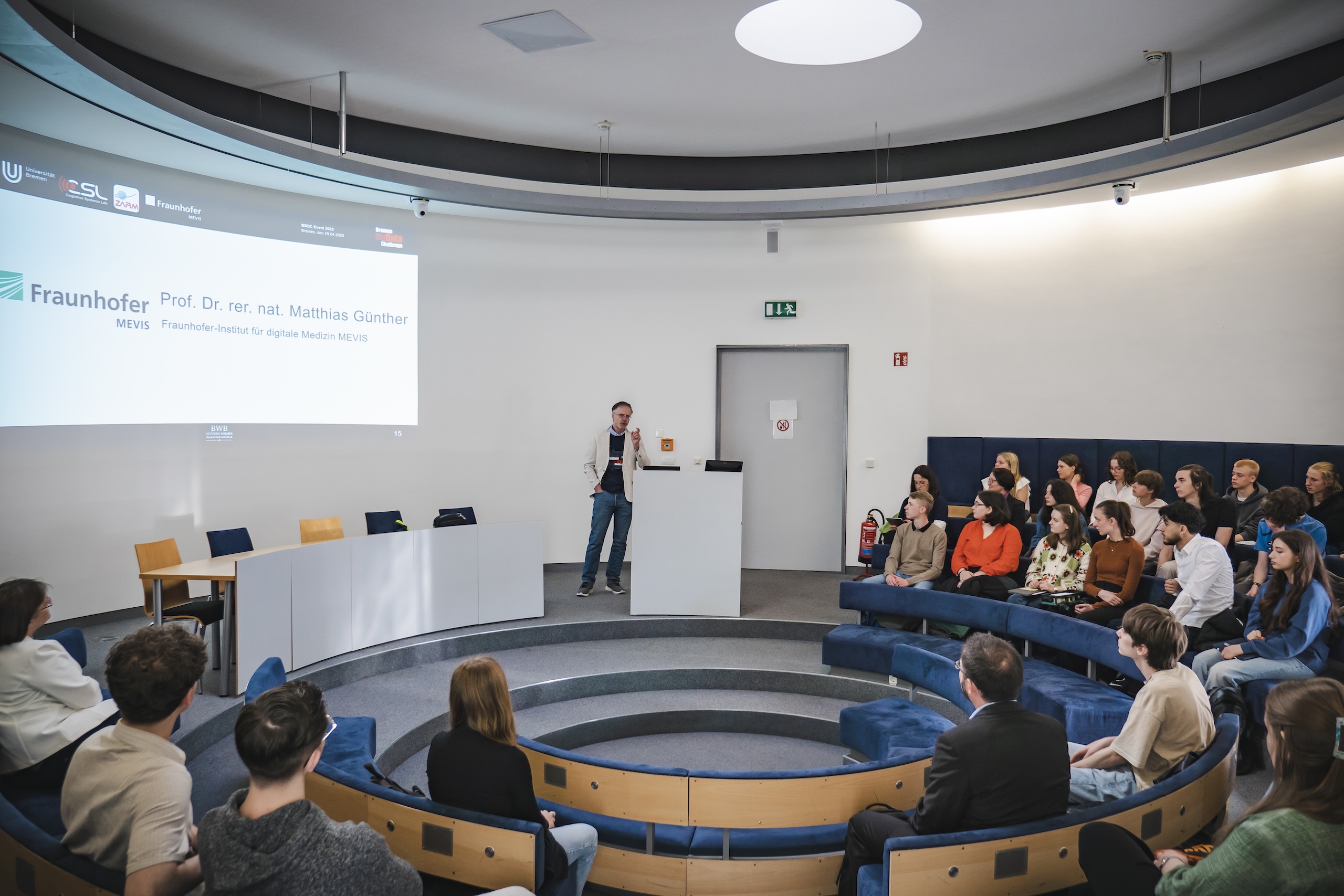

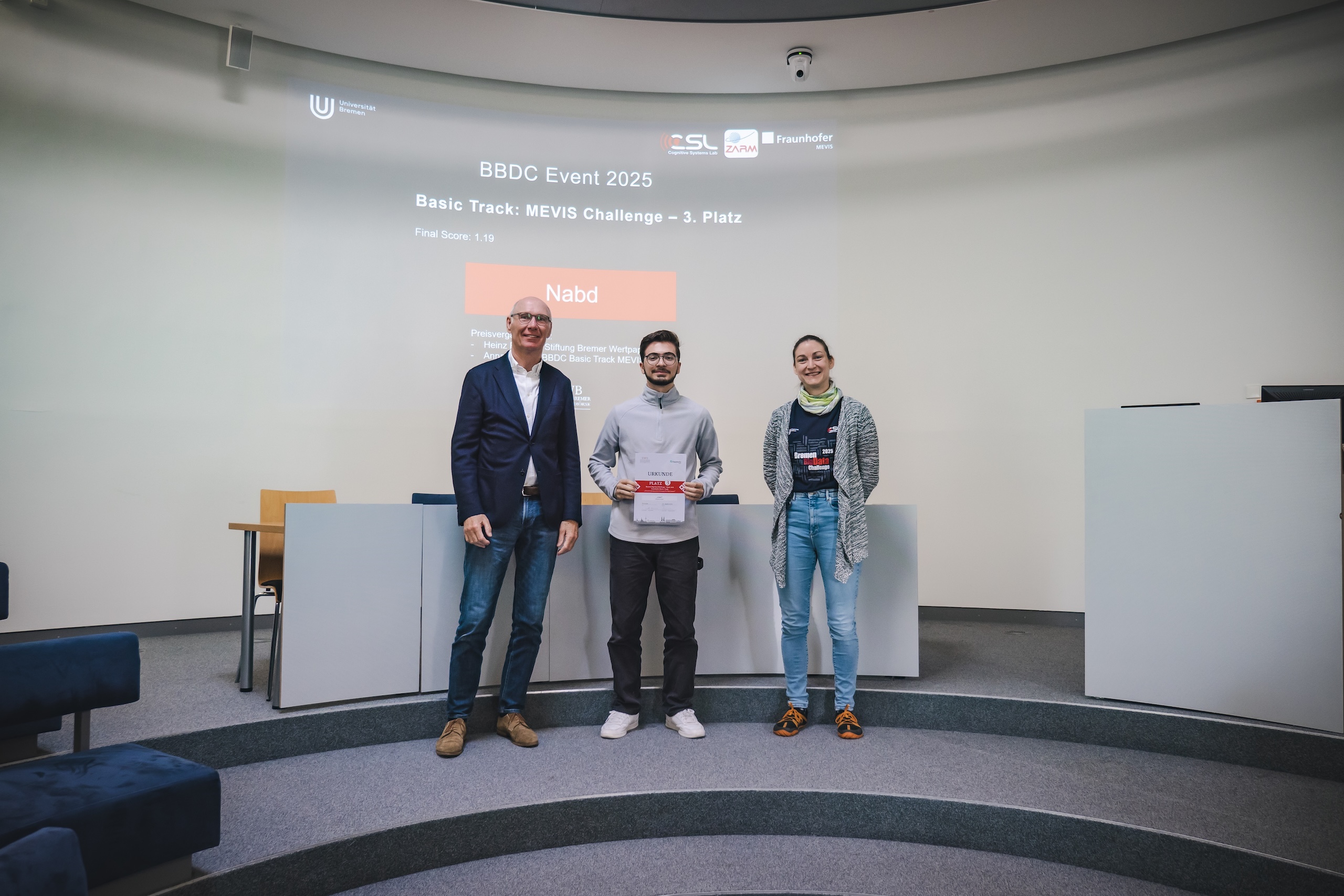
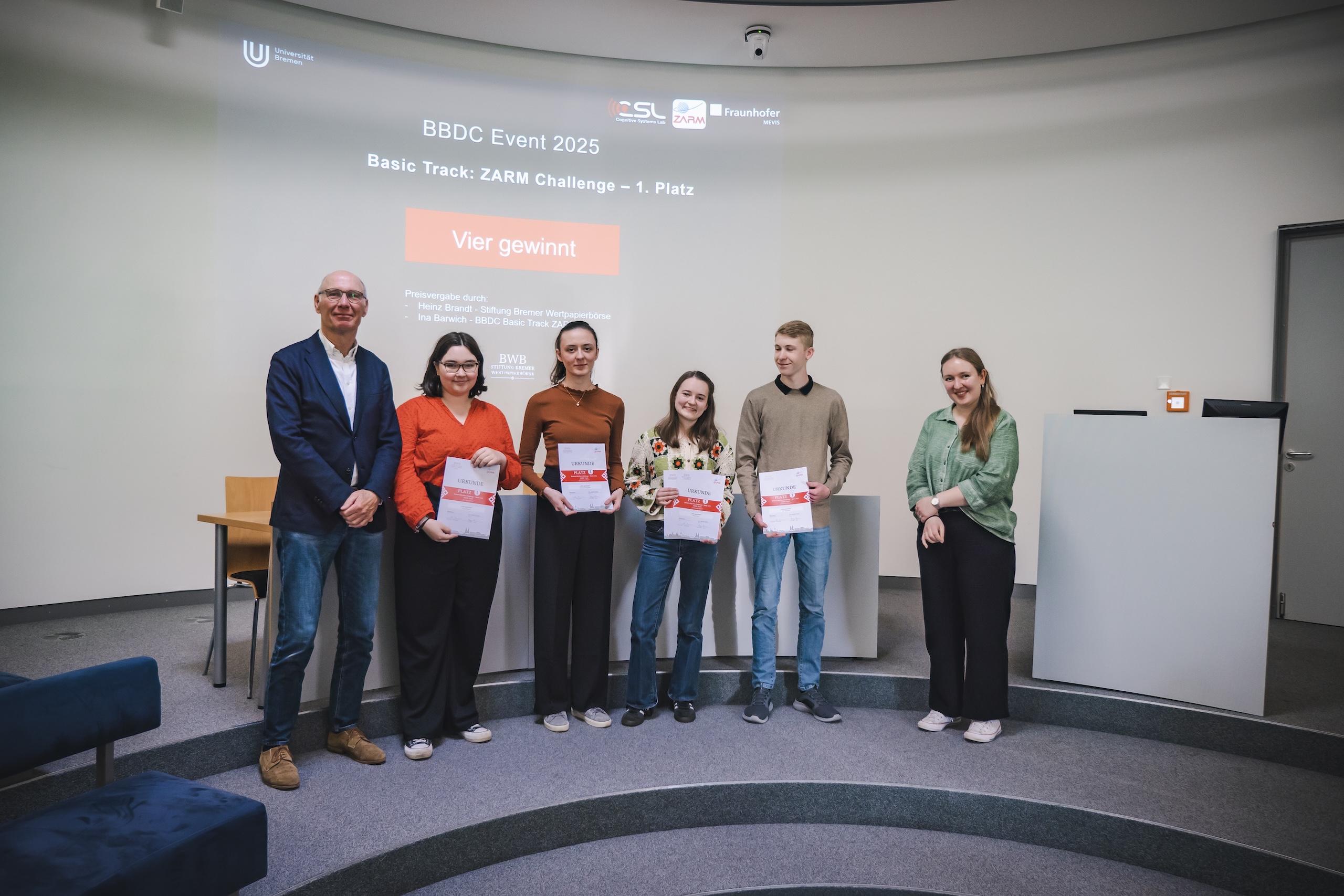
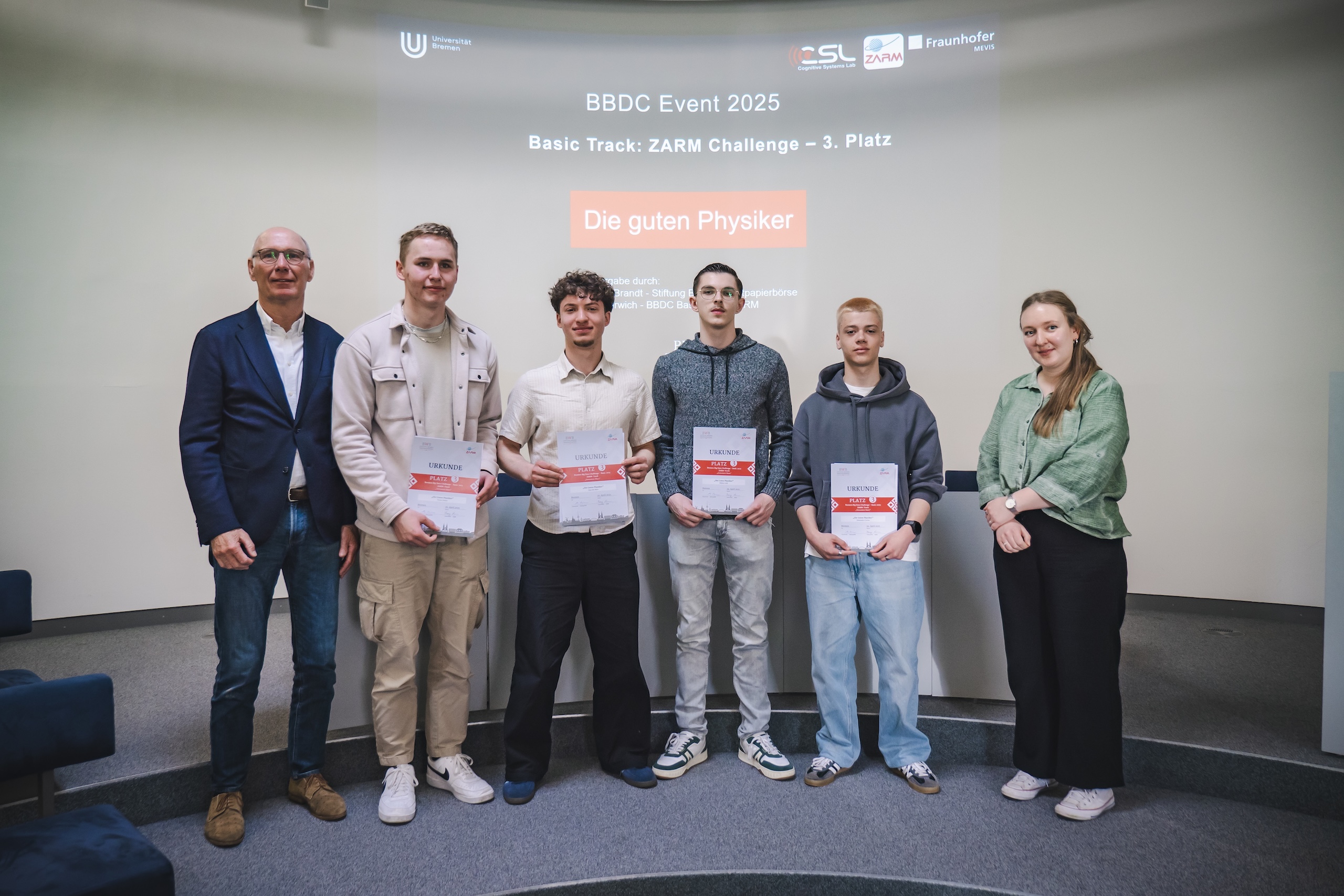
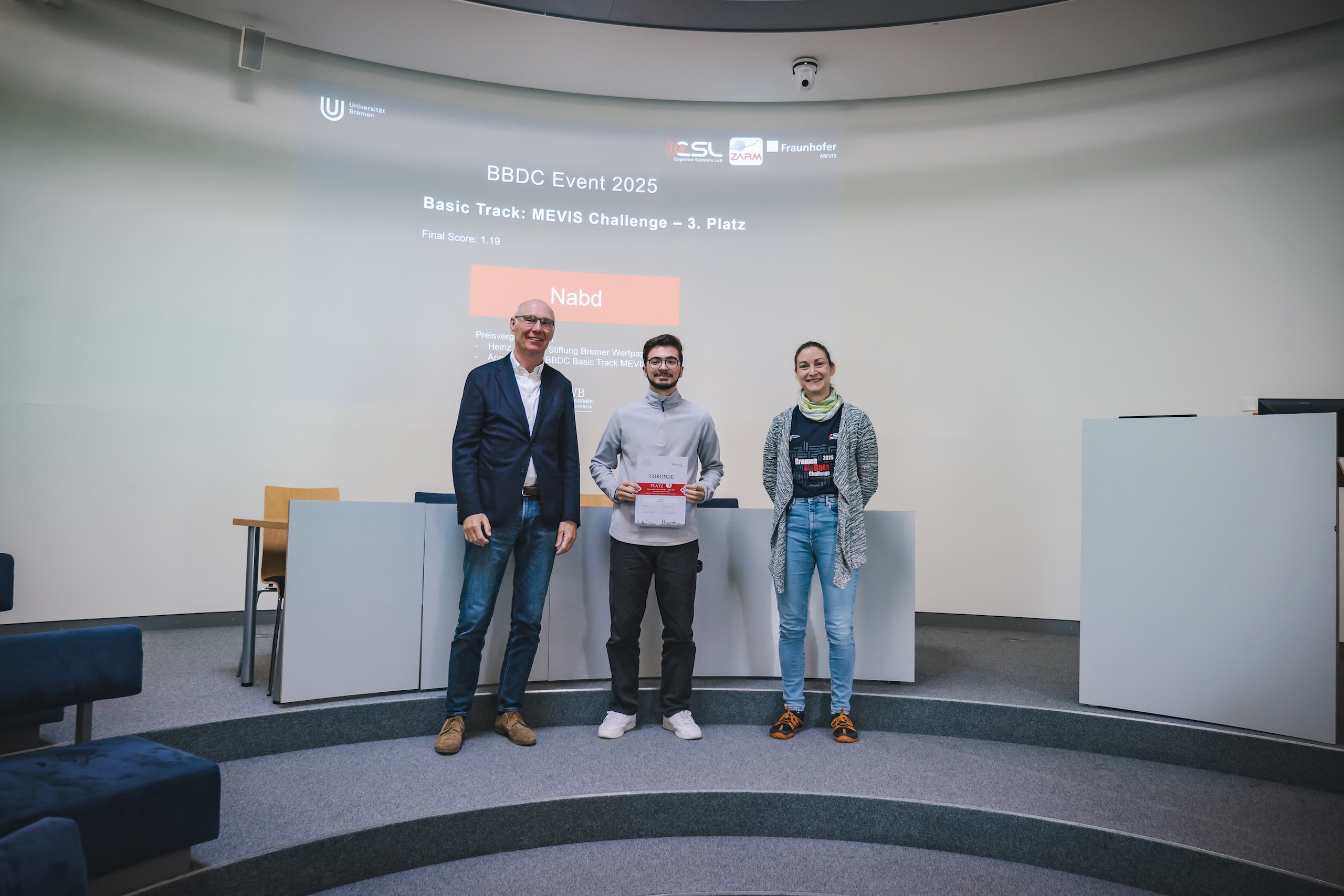
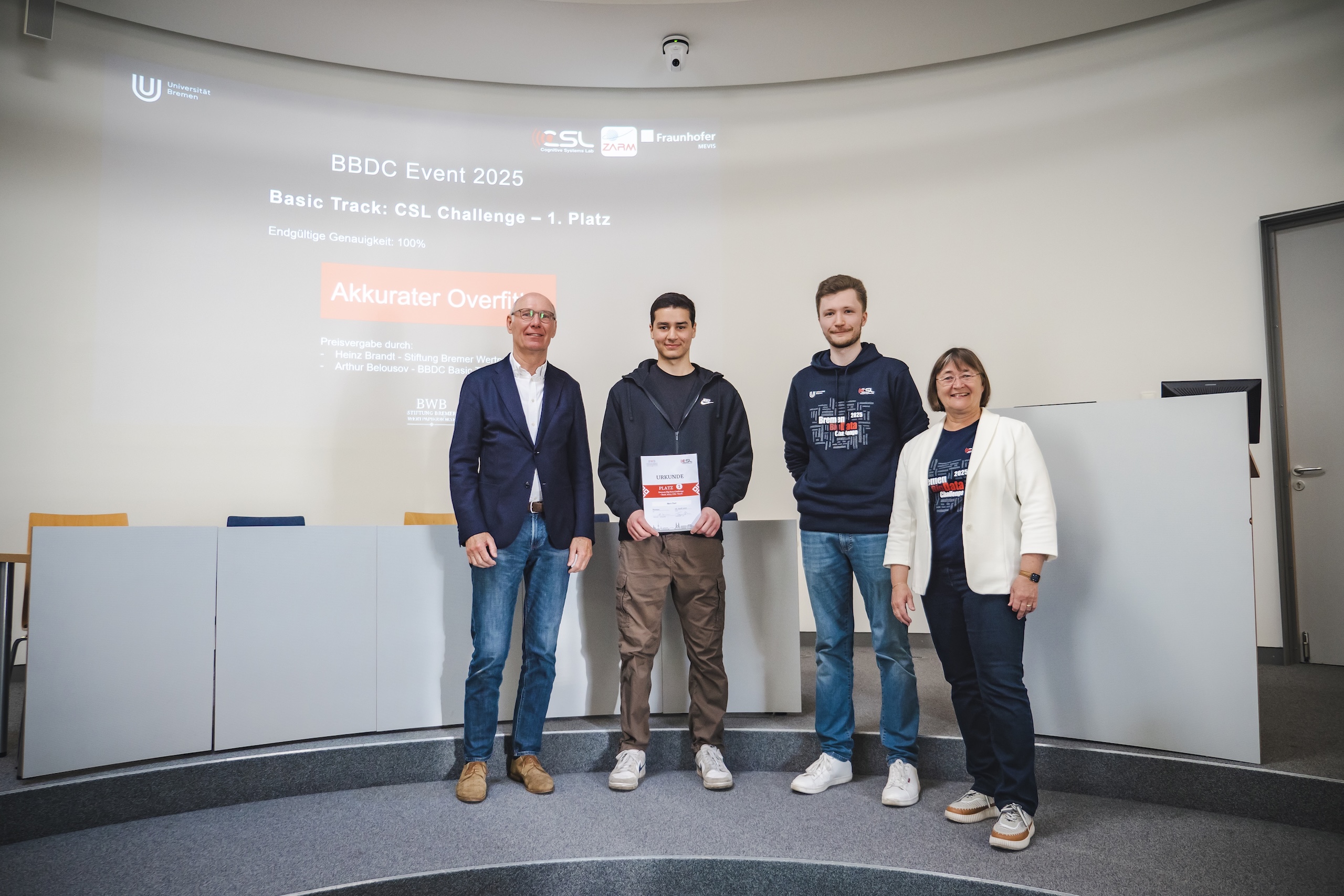
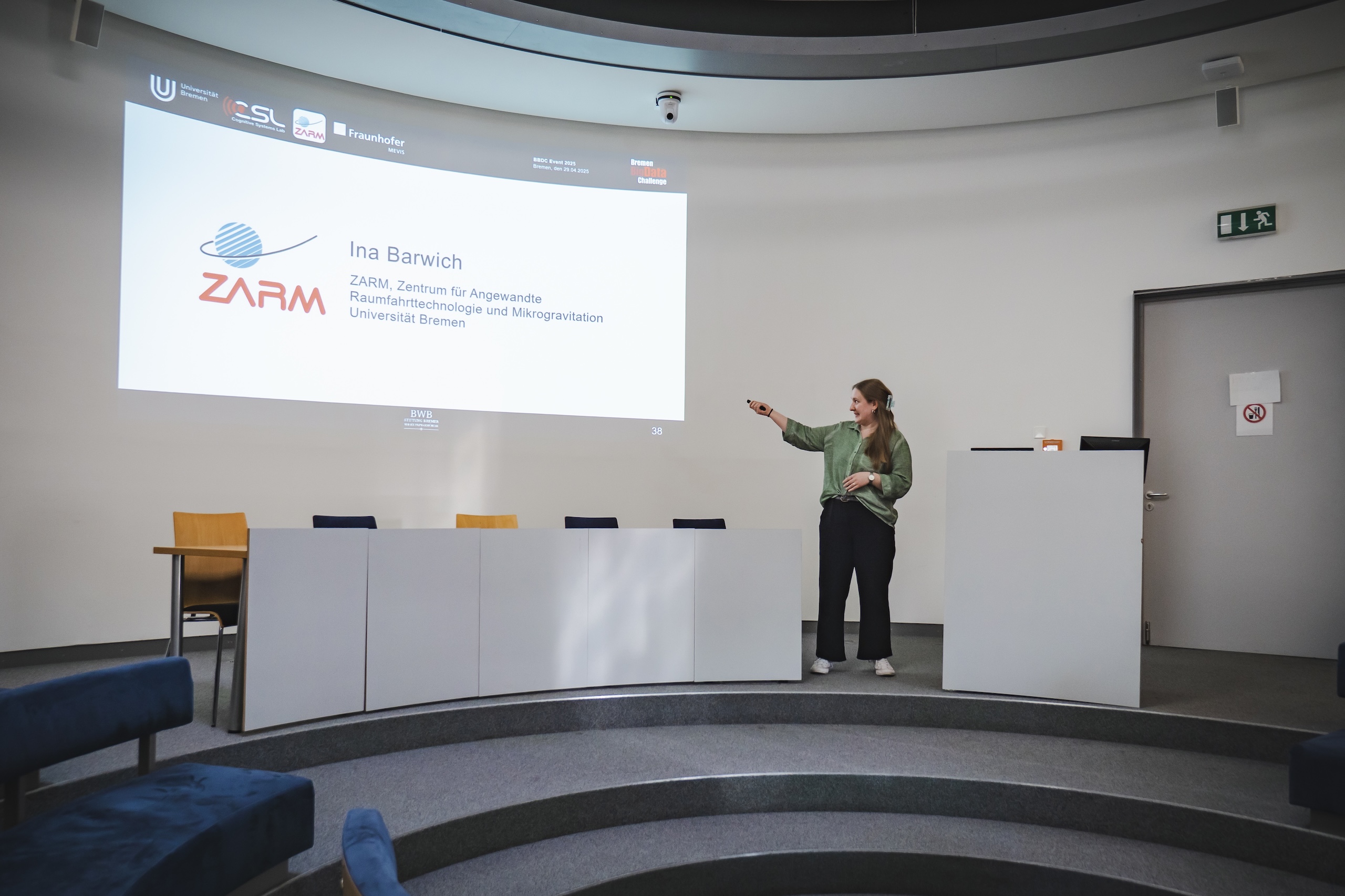
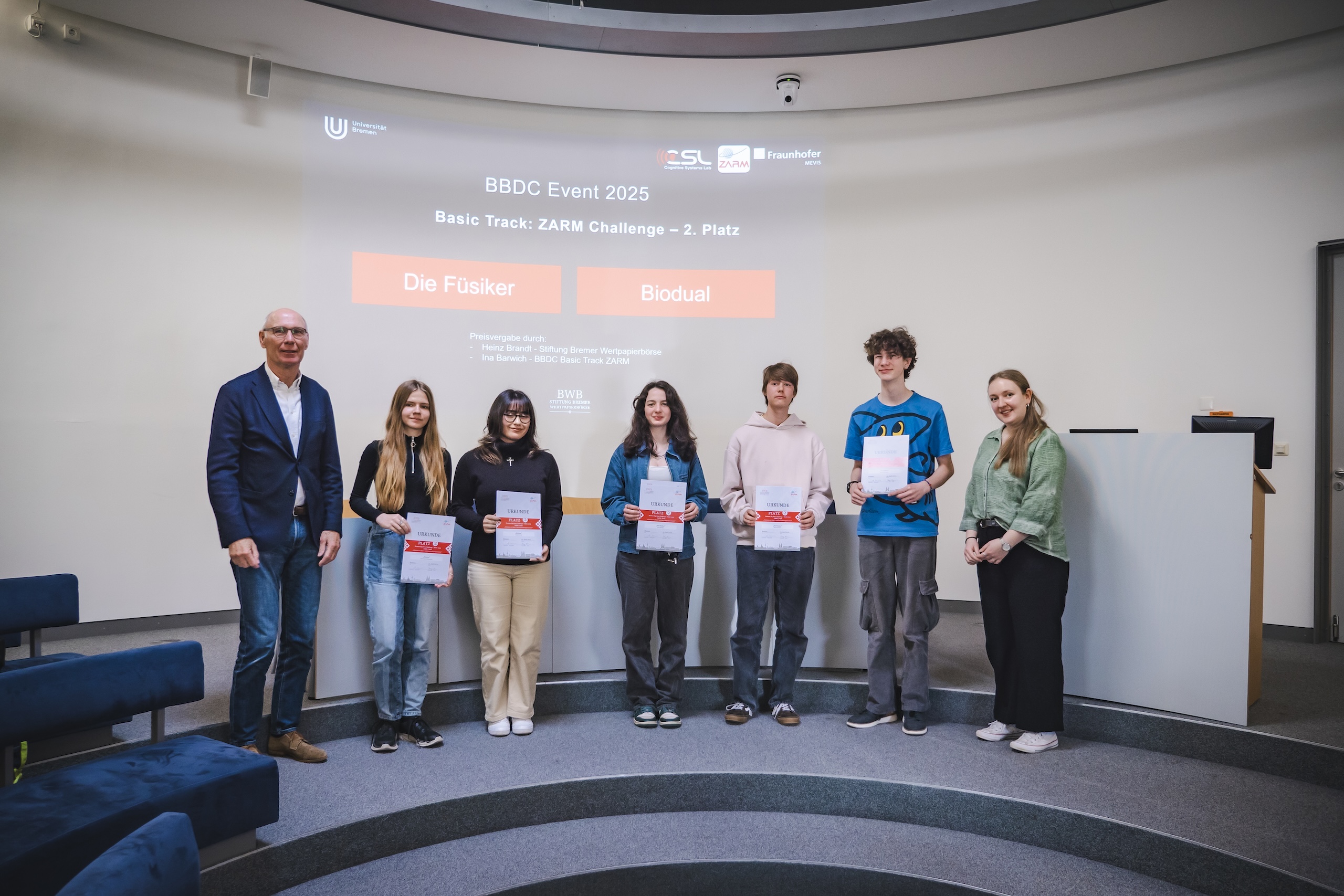
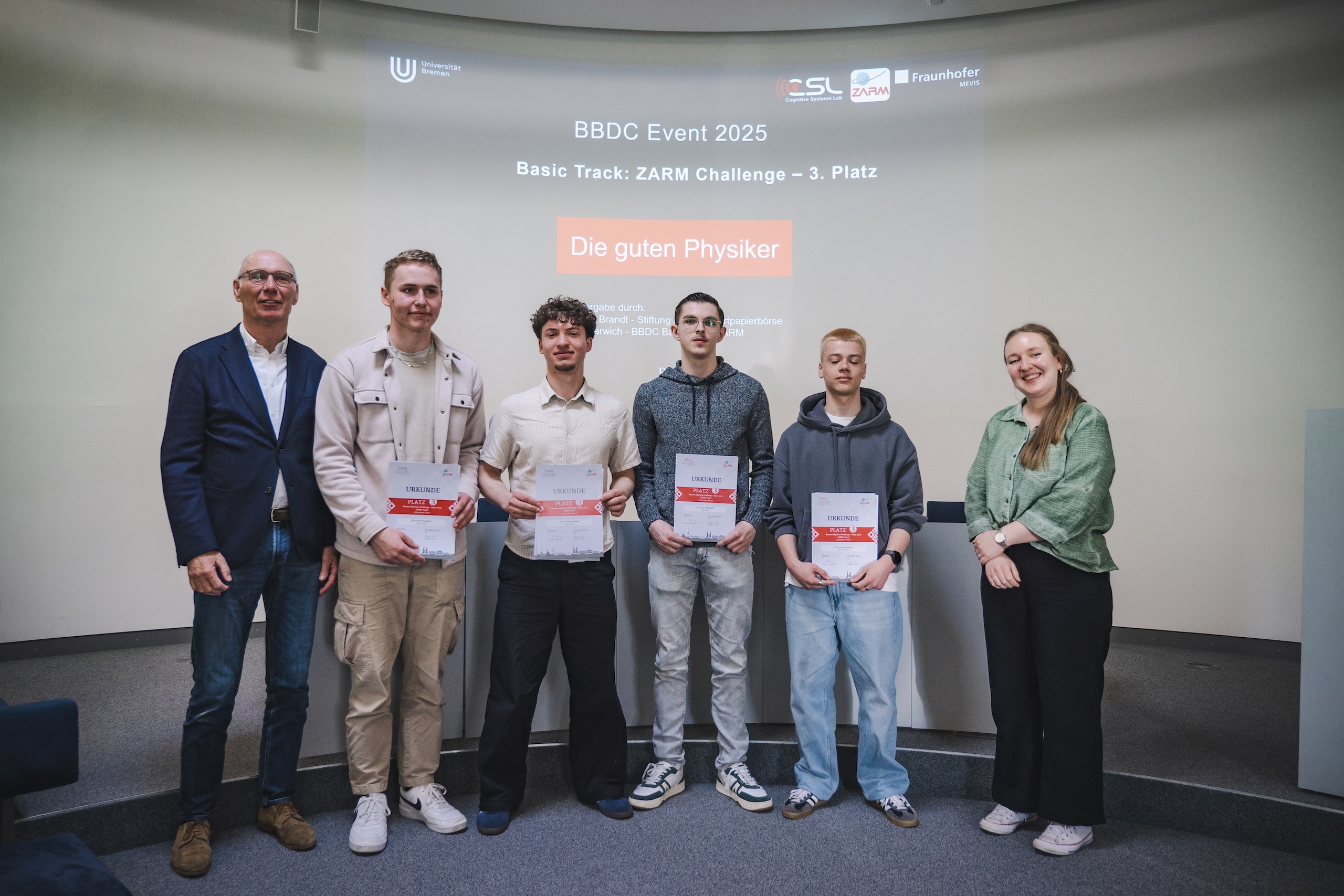
Schedule

News
Leaderboard freigeschaltet: BBDC Basic 2026
Die Leaderboards für die Challenge von CSL und MEVIS sind ab sofort verfügbar. Um eure Ergebnisse hochladen zu können, müsst ihr zunächst einen Account anlegen. Eine Registrierung des Team-Accounts erfolgt über den roten Anmelde-Button „Anmelden“ nach Auswahl der Challenge. Bitte teilt den Teamnamen unbedingt der zuständigen Ansprechperson der Challenge mit, damit eure Ergebnisse korrekt zugeordnet werden können. Einreichungen sind bis Ende 18.01.2026 möglich.
Bei Fragen oder für die Anmeldung wende dich an:
Kontakt:
- CSL-Track: belousov@uni-bremen.de
- MEVIS-Track: anna.roerich@mevis.fraunhofer.de
- ZARM-Track: ina.barwich@zarm.uni-bremen.de
MEVIS-Track Challenge
Am Fraunhofer MEVIS entwickeln Forschende, Kliniker:innen und Industriepartner gemeinsam Software-Lösungen, die Fachleuten im Gesundheitswesen helfen, die explodierende Komplexität zu bewältigen. Eine wichtige Rolle spielt dabei die Verarbeitung von medizinischen Daten mithilfe von künstlicher Intelligenz. Im Rahmen der BBDC 2025 wird es deshalb darum gehen eine künstliche Intelligenz (KI) zu trainieren, die Patholog:innen dabei unterstützt Knochenmarksausstriche mittels Automatisierung schneller und objektiver auszuwerten. Ganz konkret spielen diese Analysen bei der Diagnose von Leukämie eine entscheidende Rolle. Wie diese Knochenmarksausstriche aussehen und wie man mit diesen Daten umgeht, ist ein wichtiger Teil beim Training einer KI und der diesjährigen Challenge. Du wirst dabei erforschen, wie eine KI für die Analyse von Knochenmarksaustrichen aussehen kann, wie man sie trainiert, wie gut die resultierenden Prognosen sind und welche Limits es bei der automatischen Analyse von Knochenmarksausstrichen mit KI gibt.
Submission Deadlines:
Finale Abgabe: Bis Ende 18.01.2026
Aufgabenstellung
Analyse und Training:
Taks 0: Führe eine Datenanalyse durch. Beachte dabei die folgenden Fragen:
- Was sagen die Daten aus (Counter, MP, …)?
- Wie gehst du damit um, dass ein Patient mehrere Aufnahmen hat?
- Welche Zellklassen kommen in den Daten vor?
- Wurden alle Zellklassen bei allen Patient:innen annotiert?
- Wie sehen die Bilder aus?
- Welche KI-Modelle zur Zelldetektion gibt es bereits (Literaturrecherche)?
Task 1: Lade die Daten aus der csv-Datei und visualisiere die Bounding Boxes auf einigen Bildern.
Task 2: Definiere einen geeigneten Train-/Validation-Split.
Task 3: Trainiere ein Detektionsmodell für Leukozyten (NEC) im Knochenmark, also eine KI zur Vorhersage der Bounding-Boxes der Leukozyten.
Validierung der KI/Challenge deine KI:
- Speichere die Vorhersagen deiner KI für den Validierungsdatensatz als csv-Datei unter dem Namen „predictions.csv“. Dabei soll jede Zeile für eine vorhergesagte Bounding Box stehen, die mit x1, y1, x2, y2 angegeben wird. Die Zuordnung zum Bild geschieht über die Spalte „image_id“.
- Lade deine Datei „predictions.csv“ hier hoch und bekomme deinen Score. Der maximale Score liegt bei 1.0, das Minimum bei 0.0.
- Finale Abgabe: Lade deine Ergebnisse hier hoch. Sende ZUSÄTZLICH deinen Code an anna.roerich@mevis.fraunhofer.de. Eine Platzierung ist erst nach Abgabe eures Codes möglich.
Leaderboard MEVIS:
Challenge your AI! – Testing:
- Save the predictions of your AI for the validation dataset as a CSV file named "Prognosen.csv." Each row should represent a patient, and each column should correspond to a specific complication. If a complication occurs, a "1" should be entered in the respective column, following the format of the provided training and test data. The first row of the CSV file should contain the column names. An example format can be found in the file "Beispiel-Ergebnisse.csv."
- Please upload your "Prognosen.csv" file here to receive your score. The maximum score is 1.0, and the minimum is 0.0. The score indicates the percentage of patients for whom your predictions are correct.
- Not satisfied with your result, or others are scoring higher? Then tune your AI and give it another try!
Notes (Please Note):
- Challenge Part 1: For the evaluation of Part 1, only the last collumn of your submitted results table will be used. Therefore, all other columns may remain empty in this case.
- Challenge Part 2: For the evaluation of Part 2, all collumns of your submitted results table will be used. Therefore, the last column should also be filled according to your predictions.
Leaderboard Part 2
Organizers
- CSL-TRACK: Arthur Belousov (belousov@uni-bremen.de)
- ZARM-Track: Ina Barwich (ina.barwich@zarm.uni-bremen.de)
- MEVIS-Track: Anna Rörich (anna.roerich@mevis.fraunhofer.de)
- Technische Unterstützung: Jordan Behrendt, Matthew White, Anthony Mendil, Lourenço Rodrigues, Arthur Belousov
- Hauptverantwortliche: Tanja Schultz und Heinz Brandt
- FInancial Support:______ Bremen Stock Exchange Foundation
ZARM-Track Challenge
Sending humans to Mars and exploring our red neighboring planet has long been a dream of space exploration. However, Mars differs from Earth in many ways. The lack of atmosphere, absence of liquid water, and high radiation levels currently make it impossible to send a crew on such a journey. Instead, Mars rovers are used, but even they face numerous challenges on the Martian surface, with no direct intervention possible from Earth. When the first humans step onto Mars in a few years, additional difficulties will arise. One of these is the scarcity of resources, which must be brought from Earth and carefully utilized and recycled on Mars.
Um dieser Bandbereite an Problemstellungen einer Marsmission (mit Menschen oder ohne) gerecht zu werden, bietet das ZARM für die Challenge 2026 zwei Aufgaben an.
Submission Deadlines:
- Finaler Parkour: –
- Finaler Labortest: –
- Finale Abgabe für beide Aufgaben: –
Aufgabenstellung
Task 1 – Stress on Mars:
- Navigate slopes of 5%, 10%, and 15%, both ascending and descending
- Drive despite headwinds and crosswinds
- Drive on smooth surfaces, sand, and gravel
- Drive while carrying a load of 100g, 300g, and 500g
Task 2 – Life Support System:
- Create a project outline. Identify the types of contaminants in the water. How can these be removed? In what sequence should the recycling process occur? What materials do we need?
- Conduct initial tests at home or at school and create a list of all required materials. Send this list by November 17, 2024, to Challenge@zarm.uni-bremen.de. The material list should include all items, materials, and chemicals you need.
- Build the recycling system together with ZARM in the lab and test your idea.
- Document your work process and outline how you approached finding the solution.
ZARM – Track Leaderboard
Place
1
2
3
>3
–
–
–
–
–
Organizers
- CSL-TRACK: Arthur Belousov (belousov@uni-bremen.de)
- ZARM-Track: Ina Barwich (ina.barwich@zarm.uni-bremen.de)
- MEVIS-Track: Anna Rörich (anna.roerich@mevis.fraunhofer.de)
- Technische Unterstützung: Jordan Behrendt, Matthew White, Anthony Mendil, Lourenço Rodrigues, Arthur Belousov
- Hauptverantwortliche: Tanja Schultz und Heinz Brandt
- FInancial Support:______ Bremen Stock Exchange Foundation
CSL-Track Challenge
Der Alltag wird immer stärker durch digitale Technologien geprägt, und tragbare Geräte wie Smartwatches nehmen dabei eine zentrale Rolle ein. Sie begleiten uns unauffällig, erfassen jedoch kontinuierlich eine Vielzahl von Daten über unsere Aktivität und unseren körperlichen Zustand. Herzfrequenz, Bewegungsmuster und andere Biosignale liefern wertvolle Einblicke, doch ihre wahre Bedeutung entfaltet sich erst durch eine gezielte Analyse.
Gerade bei großen Datenmengen, wie sie moderne Sensoren erfassen, stößt die menschliche Beobachtung schnell an ihre Grenzen. Rohdaten in Millionenzeilen-Format lassen sich nicht mehr mit bloßem Auge oder einfachen Methoden auswerten. Um Muster zu erkennen, Zusammenhänge zu verstehen und verlässliche Vorhersagen zu treffen, braucht es spezialisierte Verfahren der Datenanalyse und des maschinellen Lernens.
Im Rahmen der Bremen Big Data Challenge 2026 steht genau eine solche Aufgabe im Fokus: die Klassifikation von Emotionen anhand von Biosignalen. Die hierfür bereitgestellten Daten wurden mit Smartwatches auf verschiedenen Jobmessen erfasst. Neben Beschleunigungsdaten auf den drei Achsen (X, Y, Z) liefern Photo-Plethysmographie-Sensoren (PPG) Messwerte, aus denen bereits Herzrate und „inter beat intervals“ (IBI) berechnet wurden. Zusätzlich wurden zu bestimmten Zeitpunkten die Emotionen der Teilnehmenden direkt abgefragt.
Die Challenge besteht darin, für über 48 Proband:innen auf Basis der vorhandenen Biosignale Emotionen HAPPY, RELAXED, ANGRY und SAD vorherzusagen.
Fristen
- Trainings- und Testdaten werden zum — verschickt.
- Leaderboard submissions are possible from January 15, 2025, to February 21, 2025. A total of 3 submissions are available per week. — möglich.
- Pro Woche stehen insgesamt 3 Einreichungsversuche zur Verfügung.
Aufgabenstellung
Die Herausforderung besteht darin, Emotionen auf Basis von Biosignalen zu klassifizieren, die mit Smartwatches erfasst wurden. Dafür erhalten alle Teilnehmer:innen einen Trainings- sowie einen Testdatensatz. Zur Bearbeitung dieser Aufgabe wird von dir lediglich eine beliebige Python-Entwicklungsumgebung vorausgesetzt.
Lies dir die mitgelieferte Challenge-Beschreibung sorgfältig durch, bevor du mit der Bearbeitung der Aufgabe beginnst.
Konzentriere dich zunächst auf die Datenstruktur der Trainingsdaten:
Welche Merkmale enthält der Datensatz?
Welche Bedeutung haben die einzelnen Merkmale?
Bereite den Trainingsdatensatz für deine gewählte Klassifikationsstrategie vor. Die Art der Datenaufbereitung kann sich je nach Klassifikationsmethode unterscheiden. Informiere dich deshalb über deine gewählte Methode:
Welche Datenstruktur setzt sie voraus?
Gibt es Einschränkungen, die die Leistung der Klassifikation negativ beeinflussen könnten?
Implementiere anschließend deine Klassifikationsmethode und führe ein Training auf den vorbereiteten Daten durch. Ein gutes Modell zeichnet sich nicht nur durch eine hohe Accuracy aus. Informiere dich deshalb über geeignete Evaluationsmethoden, um sicherzustellen, dass deine Ergebnisse nicht auf Zufall beruhen.
Anschließend bearbeitest du die Testdaten. Diese enthalten Zeitpunkte, an denen ursprünglich Emotionsmessungen durchgeführt wurden, die jedoch aus dem Datensatz entfernt wurden. Nutze für alle Zeitpunkte in den Testdaten die entsprechenden Informationen aus den Trainingsdaten, um die Emotionen zu klassifizieren.
Füge alle Testdaten (bestehend aus sessionId, timestamp, affect) in eine .csv-Datei ein und achte darauf, die ursprüngliche Reihenfolge beizubehalten. Lade deinen Testdatensatz mit den vorhergesagten Emotionen im BBDC Submission Portal im Track CSL hoch. Hierfür ist eine einmalige Registrierung erforderlich. Melde dich mit deinen festgelegten Zugangsdaten an und lade die vorbereitete Datei hoch.
- Zum Abschluss der Challenge sende bitte deinen Code sowie die Datensätze als .zip-Datei an folgende Adresse: belousov@uni-bremen.de.
Hinweise
Nimm dir ausreichend Zeit, um die vorliegenden Daten zu verstehen. Informiere dich hierfür zum Beispiel im Internet oder in Bibliotheken über bewährte Praktiken im Umgang mit großen Datenmengen. Achte auch auf die Verwendbarkeit deiner Daten(-punkte) und nutze nur solche, die tatsächlich aussagekräftig sind.
Nutze Visualisierungstools wie Diagramme, um sinnvolle Erkenntnisse zu gewinnen. Bewährte Python-Bibliotheken hierfür sind z. B. Matplotlib oder Plotly.
Eine gute Dokumentation deiner Arbeit, besonders für Anfänger:innen, erleichtert es später, den geschriebenen Code und die gewählten Schritte nachzuvollziehen. Schreibe daher zu jedem Schritt ein paar erklärende Sätze, damit du ihn auch später noch nachvollziehen kannst.
Bitte Beachten:
Achte darauf, dass die Labels (HAPPY, RELAXED, ANGRY, SAD) in genau diesem Format im endgültigen Datensatz vorliegen. Achte außerdem darauf, dass die geforderten Spalten in ihrer ursprünglichen Reihenfolge enthalten sind.
Der Zweck des Wettbewerbs besteht darin, zu erlernen, wie Computer mithilfe von künstlicher Intelligenz große Datenmengen verarbeiten können. Die geforderten Emotionen (Labels) müssen daher von der von dir gewählten KI generiert werden. Alle Schritte zur Generierung sollten im eingereichten Code nachvollziehbar sein. Ergebnisse, die nicht mithilfe eines Computers erzeugt wurden, werden grundsätzlich nicht akzeptiert. Sollte ersichtlich sein, dass der eingereichte Code nicht zum angegebenen Ergebnis führen kann oder gar kein Code bereitgestellt wurde, behalten wir uns das Recht vor, das Ergebnis sowie die Platzierung aus der Wertung zu entfernen.
Leaderboard CSL-Track:
Sub-Heading
- CSL-TRACK: Arthur Belousov (belousov@uni-bremen.de)
- ZARM-Track: Ina Barwich (ina.barwich@zarm.uni-bremen.de)
- MEVIS-Track: Anna Rörich (anna.roerich@mevis.fraunhofer.de)
- Technische Unterstützung: Jordan Behrendt, Matthew White, Anthony Mendil, Lourenço Rodrigues, Arthur Belousov
- Hauptverantwortliche: Tanja Schultz und Heinz Brandt
- FInancial Support:______ Bremen Stock Exchange Foundation
MEVIS-Track Challenge
Am Fraunhofer MEVIS entwickeln Forschende, Kliniker:innen und Industriepartner gemeinsam Software-Lösungen, die Fachleuten im Gesundheitswesen helfen, die explodierende Komplexität zu bewältigen. Eine wichtige Rolle spielt dabei die Verarbeitung von medizinischen Daten mithilfe von künstlicher Intelligenz. Im Rahmen der BBDC 2025 wird es deshalb darum gehen eine künstliche Intelligenz (KI) zu trainieren, die Patholog:innen dabei unterstützt Knochenmarksausstriche mittels Automatisierung schneller und objektiver auszuwerten. Ganz konkret spielen diese Analysen bei der Diagnose von Leukämie eine entscheidende Rolle. Wie diese Knochenmarksausstriche aussehen und wie man mit diesen Daten umgeht, ist ein wichtiger Teil beim Training einer KI und der diesjährigen Challenge. Du wirst dabei erforschen, wie eine KI für die Analyse von Knochenmarksaustrichen aussehen kann, wie man sie trainiert, wie gut die resultierenden Prognosen sind und welche Limits es bei der automatischen Analyse von Knochenmarksausstrichen mit KI gibt.
Submission Deadlines:
Finale Abgabe: Bis Ende 18.01.2026
Aufgabenstellung
Analyse und Training:
Taks 0: Führe eine Datenanalyse durch. Beachte dabei die folgenden Fragen:
- Was sagen die Daten aus (Counter, MP, …)?
- Wie gehst du damit um, dass ein Patient mehrere Aufnahmen hat?
- Welche Zellklassen kommen in den Daten vor?
- Wurden alle Zellklassen bei allen Patient:innen annotiert?
- Wie sehen die Bilder aus?
- Welche KI-Modelle zur Zelldetektion gibt es bereits (Literaturrecherche)?
Task 1: Lade die Daten aus der csv-Datei und visualisiere die Bounding Boxes auf einigen Bildern.
Task 2: Definiere einen geeigneten Train-/Validation-Split.
Task 3: Trainiere ein Detektionsmodell für Leukozyten (NEC) im Knochenmark, also eine KI zur Vorhersage der Bounding-Boxes der Leukozyten.
Validierung der KI/Challenge deine KI:
- Speichere die Vorhersagen deiner KI für den Validierungsdatensatz als csv-Datei unter dem Namen „predictions.csv“. Dabei soll jede Zeile für eine vorhergesagte Bounding Box stehen, die mit x1, y1, x2, y2 angegeben wird. Die Zuordnung zum Bild geschieht über die Spalte „image_id“.
- Lade deine Datei „predictions.csv“ hier hoch und bekomme deinen Score. Der maximale Score liegt bei 1.0, das Minimum bei 0.0.
- Finale Abgabe: Lade deine Ergebnisse hier hoch. Sende ZUSÄTZLICH deinen Code an anna.roerich@mevis.fraunhofer.de. Eine Platzierung ist erst nach Abgabe eures Codes möglich.
Leaderboard MEVIS:
Challenge your AI! – Testing:
- Save the predictions of your AI for the validation dataset as a CSV file named "Prognosen.csv." Each row should represent a patient, and each column should correspond to a specific complication. If a complication occurs, a "1" should be entered in the respective column, following the format of the provided training and test data. The first row of the CSV file should contain the column names. An example format can be found in the file "Beispiel-Ergebnisse.csv."
- Please upload your "Prognosen.csv" file here to receive your score. The maximum score is 1.0, and the minimum is 0.0. The score indicates the percentage of patients for whom your predictions are correct.
- Not satisfied with your result, or others are scoring higher? Then tune your AI and give it another try!
Notes (Please Note):
- Challenge Part 1: For the evaluation of Part 1, only the last collumn of your submitted results table will be used. Therefore, all other columns may remain empty in this case.
- Challenge Part 2: For the evaluation of Part 2, all collumns of your submitted results table will be used. Therefore, the last column should also be filled according to your predictions.
Leaderboard Part 2
Organizers
- CSL-TRACK: Arthur Belousov (belousov@uni-bremen.de)
- ZARM-Track: Ina Barwich (ina.barwich@zarm.uni-bremen.de)
- MEVIS-Track: Anna Rörich (anna.roerich@mevis.fraunhofer.de)
- Technische Unterstützung: Jordan Behrendt, Matthew White, Anthony Mendil, Lourenço Rodrigues, Arthur Belousov
- Hauptverantwortliche: Tanja Schultz und Heinz Brandt
- FInancial Support:______ Bremen Stock Exchange Foundation
ZARM-Track Challenge
Sending humans to Mars and exploring our red neighboring planet has long been a dream of space exploration. However, Mars differs from Earth in many ways. The lack of atmosphere, absence of liquid water, and high radiation levels currently make it impossible to send a crew on such a journey. Instead, Mars rovers are used, but even they face numerous challenges on the Martian surface, with no direct intervention possible from Earth. When the first humans step onto Mars in a few years, additional difficulties will arise. One of these is the scarcity of resources, which must be brought from Earth and carefully utilized and recycled on Mars.
Um dieser Bandbereite an Problemstellungen einer Marsmission (mit Menschen oder ohne) gerecht zu werden, bietet das ZARM für die Challenge 2026 zwei Aufgaben an.
Submission Deadlines:
- Finaler Parkour: –
- Finaler Labortest: –
- Finale Abgabe für beide Aufgaben: –
Aufgabenstellung
Task 1 – Stress on Mars:
- Navigate slopes of 5%, 10%, and 15%, both ascending and descending
- Drive despite headwinds and crosswinds
- Drive on smooth surfaces, sand, and gravel
- Drive while carrying a load of 100g, 300g, and 500g
Task 2 – Life Support System:
- Create a project outline. Identify the types of contaminants in the water. How can these be removed? In what sequence should the recycling process occur? What materials do we need?
- Conduct initial tests at home or at school and create a list of all required materials. Send this list by November 17, 2024, to Challenge@zarm.uni-bremen.de. The material list should include all items, materials, and chemicals you need.
- Build the recycling system together with ZARM in the lab and test your idea.
- Document your work process and outline how you approached finding the solution.
ZARM – Track Leaderboard
Place
1
2
3
>3
–
–
–
–
–
Organizers
- CSL-TRACK: Arthur Belousov (belousov@uni-bremen.de)
- ZARM-Track: Ina Barwich (ina.barwich@zarm.uni-bremen.de)
- MEVIS-Track: Anna Rörich (anna.roerich@mevis.fraunhofer.de)
- Technische Unterstützung: Jordan Behrendt, Matthew White, Anthony Mendil, Lourenço Rodrigues, Arthur Belousov
- Hauptverantwortliche: Tanja Schultz und Heinz Brandt
- FInancial Support:______ Bremen Stock Exchange Foundation
CSL-Track Challenge
Der Alltag wird immer stärker durch digitale Technologien geprägt, und tragbare Geräte wie Smartwatches nehmen dabei eine zentrale Rolle ein. Sie begleiten uns unauffällig, erfassen jedoch kontinuierlich eine Vielzahl von Daten über unsere Aktivität und unseren körperlichen Zustand. Herzfrequenz, Bewegungsmuster und andere Biosignale liefern wertvolle Einblicke, doch ihre wahre Bedeutung entfaltet sich erst durch eine gezielte Analyse.
Gerade bei großen Datenmengen, wie sie moderne Sensoren erfassen, stößt die menschliche Beobachtung schnell an ihre Grenzen. Rohdaten in Millionenzeilen-Format lassen sich nicht mehr mit bloßem Auge oder einfachen Methoden auswerten. Um Muster zu erkennen, Zusammenhänge zu verstehen und verlässliche Vorhersagen zu treffen, braucht es spezialisierte Verfahren der Datenanalyse und des maschinellen Lernens.
Im Rahmen der Bremen Big Data Challenge 2026 steht genau eine solche Aufgabe im Fokus: die Klassifikation von Emotionen anhand von Biosignalen. Die hierfür bereitgestellten Daten wurden mit Smartwatches auf verschiedenen Jobmessen erfasst. Neben Beschleunigungsdaten auf den drei Achsen (X, Y, Z) liefern Photo-Plethysmographie-Sensoren (PPG) Messwerte, aus denen bereits Herzrate und „inter beat intervals“ (IBI) berechnet wurden. Zusätzlich wurden zu bestimmten Zeitpunkten die Emotionen der Teilnehmenden direkt abgefragt.
Die Challenge besteht darin, für über 48 Proband:innen auf Basis der vorhandenen Biosignale Emotionen HAPPY, RELAXED, ANGRY und SAD vorherzusagen.
Fristen
- Trainings- und Testdaten werden zum — verschickt.
- Leaderboard submissions are possible from January 15, 2025, to February 21, 2025. A total of 3 submissions are available per week. — möglich.
- Pro Woche stehen insgesamt 3 Einreichungsversuche zur Verfügung.
Aufgabenstellung
Die Herausforderung besteht darin, Emotionen auf Basis von Biosignalen zu klassifizieren, die mit Smartwatches erfasst wurden. Dafür erhalten alle Teilnehmer:innen einen Trainings- sowie einen Testdatensatz. Zur Bearbeitung dieser Aufgabe wird von dir lediglich eine beliebige Python-Entwicklungsumgebung vorausgesetzt.
Lies dir die mitgelieferte Challenge-Beschreibung sorgfältig durch, bevor du mit der Bearbeitung der Aufgabe beginnst.
Konzentriere dich zunächst auf die Datenstruktur der Trainingsdaten:
Welche Merkmale enthält der Datensatz?
Welche Bedeutung haben die einzelnen Merkmale?
Bereite den Trainingsdatensatz für deine gewählte Klassifikationsstrategie vor. Die Art der Datenaufbereitung kann sich je nach Klassifikationsmethode unterscheiden. Informiere dich deshalb über deine gewählte Methode:
Welche Datenstruktur setzt sie voraus?
Gibt es Einschränkungen, die die Leistung der Klassifikation negativ beeinflussen könnten?
Implementiere anschließend deine Klassifikationsmethode und führe ein Training auf den vorbereiteten Daten durch. Ein gutes Modell zeichnet sich nicht nur durch eine hohe Accuracy aus. Informiere dich deshalb über geeignete Evaluationsmethoden, um sicherzustellen, dass deine Ergebnisse nicht auf Zufall beruhen.
Anschließend bearbeitest du die Testdaten. Diese enthalten Zeitpunkte, an denen ursprünglich Emotionsmessungen durchgeführt wurden, die jedoch aus dem Datensatz entfernt wurden. Nutze für alle Zeitpunkte in den Testdaten die entsprechenden Informationen aus den Trainingsdaten, um die Emotionen zu klassifizieren.
Füge alle Testdaten (bestehend aus sessionId, timestamp, affect) in eine .csv-Datei ein und achte darauf, die ursprüngliche Reihenfolge beizubehalten. Lade deinen Testdatensatz mit den vorhergesagten Emotionen im BBDC Submission Portal im Track CSL hoch. Hierfür ist eine einmalige Registrierung erforderlich. Melde dich mit deinen festgelegten Zugangsdaten an und lade die vorbereitete Datei hoch.
- Zum Abschluss der Challenge sende bitte deinen Code sowie die Datensätze als .zip-Datei an folgende Adresse: belousov@uni-bremen.de.
Hinweise
Nimm dir ausreichend Zeit, um die vorliegenden Daten zu verstehen. Informiere dich hierfür zum Beispiel im Internet oder in Bibliotheken über bewährte Praktiken im Umgang mit großen Datenmengen. Achte auch auf die Verwendbarkeit deiner Daten(-punkte) und nutze nur solche, die tatsächlich aussagekräftig sind.
Nutze Visualisierungstools wie Diagramme, um sinnvolle Erkenntnisse zu gewinnen. Bewährte Python-Bibliotheken hierfür sind z. B. Matplotlib oder Plotly.
Eine gute Dokumentation deiner Arbeit, besonders für Anfänger:innen, erleichtert es später, den geschriebenen Code und die gewählten Schritte nachzuvollziehen. Schreibe daher zu jedem Schritt ein paar erklärende Sätze, damit du ihn auch später noch nachvollziehen kannst.
Bitte Beachten:
Achte darauf, dass die Labels (HAPPY, RELAXED, ANGRY, SAD) in genau diesem Format im endgültigen Datensatz vorliegen. Achte außerdem darauf, dass die geforderten Spalten in ihrer ursprünglichen Reihenfolge enthalten sind.
Der Zweck des Wettbewerbs besteht darin, zu erlernen, wie Computer mithilfe von künstlicher Intelligenz große Datenmengen verarbeiten können. Die geforderten Emotionen (Labels) müssen daher von der von dir gewählten KI generiert werden. Alle Schritte zur Generierung sollten im eingereichten Code nachvollziehbar sein. Ergebnisse, die nicht mithilfe eines Computers erzeugt wurden, werden grundsätzlich nicht akzeptiert. Sollte ersichtlich sein, dass der eingereichte Code nicht zum angegebenen Ergebnis führen kann oder gar kein Code bereitgestellt wurde, behalten wir uns das Recht vor, das Ergebnis sowie die Platzierung aus der Wertung zu entfernen.
Leaderboard CSL-Track:
Sub-Heading
- CSL-TRACK: Arthur Belousov (belousov@uni-bremen.de)
- ZARM-Track: Ina Barwich (ina.barwich@zarm.uni-bremen.de)
- MEVIS-Track: Anna Rörich (anna.roerich@mevis.fraunhofer.de)
- Technische Unterstützung: Jordan Behrendt, Matthew White, Anthony Mendil, Lourenço Rodrigues, Arthur Belousov
- Hauptverantwortliche: Tanja Schultz und Heinz Brandt
- FInancial Support:______ Bremen Stock Exchange Foundation
